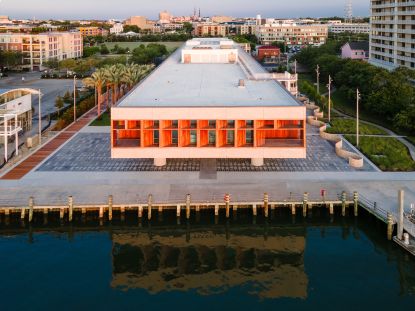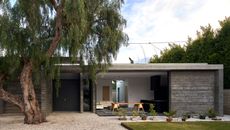International African American Museum celebrates life and memory on 'hallowed ground'
The International African American Museum opens in Charleston, USA, acknowledging 'hallowed ground' and celebrating life and memory

After more than two decades in the making, the International African American Museum (IAAM) is about to open its doors to the public. Located in Charleston, South Carolina, the new American institution is fully dedicated to telling the stories of enslaved Africans brought to North America in the 18th and 19th centuries and celebrating their and their descendants' lives and contributions. The much-anticipated opening is highlighted further by a striking design created by a team comprising architects Pei Cobb Freed & Partners and Moody Nolan, landscape designers Hood Design Studio, and exhibition designers Ralph Appelbaum Associates.

International African American Museum: honouring sacred ground
'As the place where thousands of Africans from diverse cultures first set foot in North America,' wrote lead designer the late Henry N Cobb at the project’s inception, commenting on the site, which was the port of arrival for nearly half of all enslaved Africans brought to North America, 'Gadsden’s Wharf is not just the right place to tell this story; it is hallowed ground. The special design challenge of the museum is to build on this site without occupying it.'

'The International African American Museum is more than a mark of architecture, it’s an extraordinary milestone,' said Curt Moody, founder of Moody Nolan. 'Having worked for the last 15 years to dream this into being, we are intimately aware of the cultural significance it has for American history. Without this building, this sacred site would have remained unknown and the stories of our ancestors untold. It’s an honour and a privilege to work on a project that has this kind of tenacity, and we recognise that the opportunity to leave an impression on people around the world, for generations to come, is a rare gift.'

The IAAM design lifts its imposing, expansive 426ft-long, 84ft-wide, single-storey main volume 13ft above ground, standing on 18 cylindrical pillars. Underneath and around it, public spaces of all kinds unfold, from open, flexible terraces to green enclosures and sculpture gardens. The openness represents 'the heart of the site’s collective memory', its authors explain. Amid this context, the African Ancestors Memorial Garden by Hood Design Studio invites reflection and remembrance.

'The Ancestors Garden – the site where many enslaved Africans first touched North America – is a series of spaces and exhibits that establishes this site as an authentic place of arrival, a place for becoming. The ground beneath the museum is the artifact of the site. As a rich tapestry of water, tabby [a lime and seashell-based material], grasses, wood, and stone, the hallowed ground and landscape spaces offer contemplation, celebration, and fraught memories,' says practice creative director Walter Hood.

Following a grand launch on 24 June 2023, the International African American Museum will officially open to the public on 27 June.


Ellie Stathaki is the Architecture Editor at Wallpaper*. She trained as an architect at the Aristotle University of Thessaloniki in Greece and studied architectural history at the Bartlett in London. Now an established journalist, she has been a member of the Wallpaper* team since 2006, visiting buildings across the globe and interviewing leading architects such as Tadao Ando and Rem Koolhaas. Ellie has also taken part in judging panels, moderated events, curated shows and contributed in books, such as The Contemporary House (Thames & Hudson, 2018) and Glenn Sestig Architecture Diary (2020).
-
 Blue Nomad Floating Habitat is a prototype dwelling for a drowning world
Blue Nomad Floating Habitat is a prototype dwelling for a drowning worldInspired by traditional ocean-going vessels, the Blue Nomad Floating Habitat is a prototype dwelling for a drowning world, shaped by students from Rosenberg
By Jonathan Bell • Published
-
 A Hermosa Beach house by XTEN champions minimalist beachside living
A Hermosa Beach house by XTEN champions minimalist beachside livingStrandhouse by XTEN is a Hermosa Beach house designed to offer minimalist surrounds and the best architectural accompaniment to its seaside location
By Ellie Stathaki • Published
-
 Mercedes EQE SUV brings more tech to the fore
Mercedes EQE SUV brings more tech to the forePremium electrification means imposing scale and unavoidable technology in the all-conquering Mercedes EQE SUV
By Rory FH Smith • Published
-
 A Hermosa Beach house by XTEN champions minimalist beachside living
A Hermosa Beach house by XTEN champions minimalist beachside livingStrandhouse by XTEN is a Hermosa Beach house designed to offer minimalist surrounds and the best architectural accompaniment to its seaside location
By Ellie Stathaki • Published
-
 One High Line’s twisting towers by BIG dance in New York
One High Line’s twisting towers by BIG dance in New YorkOne High Line by Bjarke Ingels’ BIG is completed in New York, including a home interior by designer Dan Fink
By Ellie Stathaki • Published
-
 Oza Sabbeth’s ‘radical reimagination’ of a Hamptons house
Oza Sabbeth’s ‘radical reimagination’ of a Hamptons houseA ‘radical reimagination’ by Oza Sabbeth Architects has given a dramatic new look and layout to an existing timber structure in the Hamptons
By Ellie Stathaki • Published
-
 House 5 by LADG explores Los Angeles’ suburban typologies
House 5 by LADG explores Los Angeles’ suburban typologiesHouse 5 by architecture studio The Los Angeles Design Group (LADG) offers a contemporary alternative to the city's suburban homes
By Ellie Stathaki • Published
-
 Buffalo AKG Art Museum opens, inviting us into its OMA-designed home
Buffalo AKG Art Museum opens, inviting us into its OMA-designed homeBuffalo AKG Art Museum opens its new, OMA-designed home in the USA
By Ellie Stathaki • Published
-
 Bonsai House was conceived as a gallery for a collection of miniature trees
Bonsai House was conceived as a gallery for a collection of miniature treesBonsai House by Matthew Royce Architecture is a residential extension in Venice, California, conceived as a viewing gallery for the owners' collection of miniature trees
By Ellie Stathaki • Published
-
 Idyllic Wine Country barn creates family retreat that communes with the outdoors
Idyllic Wine Country barn creates family retreat that communes with the outdoorsA Wine Country barn in California becomes an idyllic, sensitive retreat for a San Francisco family, courtesy of Malcolm Davis Architecture
By Ellie Stathaki • Published
-
 Space Invader swathes a 1970s Berkeley house in a ‘low-resolution’ wrapper
Space Invader swathes a 1970s Berkeley house in a ‘low-resolution’ wrapperSpace Invader by OPA is the modern reimagining of a 1970s San Francisco house
By Ellie Stathaki • Published









